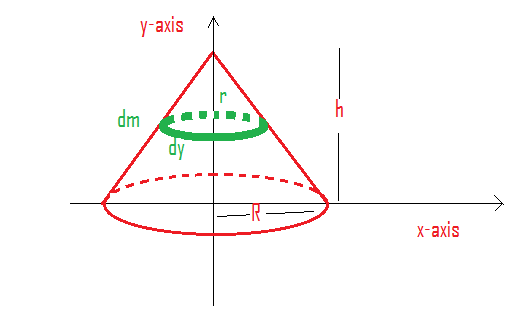
Answer
438.6k+ views
Hint: The center of mass is a point on the body where all of its mass is assumed to be concentrated. In the case of a rigid body, the center of mass is fixed and if the body has uniform density it will be located at the centroid.
Complete step by step answer:
Let us take a small element dm of thickness $dy$ as shown in the figure.

Let us first write the expression for a small element $dm$.
$dm = \dfrac{{mass}}{{volume}} \times \text{volume of small element}$
Let us substitute the values.
$dm = \dfrac{m}{{\pi {R^2}h/3}} \times \pi {r^2}dy$ ………………... (1)
Let us apply the property of similarity of triangles.
$\dfrac{r}{y} = \dfrac{R}{h}$
From this let us substitute the value of ‘$r$’ in equation (1).
$dm = \dfrac{{3m}}{{\pi {R^2}h}} \times \pi {(\dfrac{{Ry}}{h})^2}dy$
Let us further simplify the expression.
$dm = \dfrac{{3m{y^2}}}{{{h^3}}}dy$ ………... (2)
Now let us write the expression for the center of mass of a small element.
${y_c} = \dfrac{1}{m}\int {ydm} $
Let us substitute the value from equation (2).
${y_c} = \dfrac{1}{m}\int\limits_0^h {\dfrac{{3m{y^2}}}{{{h^3}}}.ydy} $
Let us take constants outside of the integral and re-write the expression.
${y_c} = \dfrac{3}{{{h^3}}}\int\limits_0^h {{y^3}dy} $
Let us integrate the expression.
${y_c} = \dfrac{3}{{{h^3}}}\left( {\dfrac{{{y^4}}}{4}} \right)_0^h$
Let us apply the limits.
${y_c} = \dfrac{3}{{{h^3}}}\left( {\dfrac{{{h^4}}}{4}} \right) = \dfrac{{3h}}{4}$
$\therefore $ The center of mass from the top of the cone is $\dfrac{3h}{4}$.
Note:
If two pairs of corresponding angles in a pair of triangles are congruent, then the triangles are similar.
Two triangles are similar if and only if corresponding angles have the same measure that means they are similar if and only if the lengths of corresponding sides are proportional.
The center of mass is useful for calculations in mechanics which involve masses distributed in space, for example, the linear momentum and angular momentum of planetary bodies and rigid body dynamics.
In orbital mechanics also the equations of motion of planets are written as point masses located at the centers of mass.
Complete step by step answer:
Let us take a small element dm of thickness $dy$ as shown in the figure.

Let us first write the expression for a small element $dm$.
$dm = \dfrac{{mass}}{{volume}} \times \text{volume of small element}$
Let us substitute the values.
$dm = \dfrac{m}{{\pi {R^2}h/3}} \times \pi {r^2}dy$ ………………... (1)
Let us apply the property of similarity of triangles.
$\dfrac{r}{y} = \dfrac{R}{h}$
From this let us substitute the value of ‘$r$’ in equation (1).
$dm = \dfrac{{3m}}{{\pi {R^2}h}} \times \pi {(\dfrac{{Ry}}{h})^2}dy$
Let us further simplify the expression.
$dm = \dfrac{{3m{y^2}}}{{{h^3}}}dy$ ………... (2)
Now let us write the expression for the center of mass of a small element.
${y_c} = \dfrac{1}{m}\int {ydm} $
Let us substitute the value from equation (2).
${y_c} = \dfrac{1}{m}\int\limits_0^h {\dfrac{{3m{y^2}}}{{{h^3}}}.ydy} $
Let us take constants outside of the integral and re-write the expression.
${y_c} = \dfrac{3}{{{h^3}}}\int\limits_0^h {{y^3}dy} $
Let us integrate the expression.
${y_c} = \dfrac{3}{{{h^3}}}\left( {\dfrac{{{y^4}}}{4}} \right)_0^h$
Let us apply the limits.
${y_c} = \dfrac{3}{{{h^3}}}\left( {\dfrac{{{h^4}}}{4}} \right) = \dfrac{{3h}}{4}$
$\therefore $ The center of mass from the top of the cone is $\dfrac{3h}{4}$.
Note:
If two pairs of corresponding angles in a pair of triangles are congruent, then the triangles are similar.
Two triangles are similar if and only if corresponding angles have the same measure that means they are similar if and only if the lengths of corresponding sides are proportional.
The center of mass is useful for calculations in mechanics which involve masses distributed in space, for example, the linear momentum and angular momentum of planetary bodies and rigid body dynamics.
In orbital mechanics also the equations of motion of planets are written as point masses located at the centers of mass.
Recently Updated Pages
How many sigma and pi bonds are present in HCequiv class 11 chemistry CBSE

Mark and label the given geoinformation on the outline class 11 social science CBSE

When people say No pun intended what does that mea class 8 english CBSE

Name the states which share their boundary with Indias class 9 social science CBSE

Give an account of the Northern Plains of India class 9 social science CBSE

Change the following sentences into negative and interrogative class 10 english CBSE

Trending doubts
During the region of which ruler Moroccan Traveller class 12 social science CBSE

Fill the blanks with the suitable prepositions 1 The class 9 english CBSE

Differentiate between homogeneous and heterogeneous class 12 chemistry CBSE

Difference Between Plant Cell and Animal Cell

Difference between Prokaryotic cell and Eukaryotic class 11 biology CBSE

Give 10 examples for herbs , shrubs , climbers , creepers

Which are the Top 10 Largest Countries of the World?

Write a letter to the principal requesting him to grant class 10 english CBSE

A milkman adds a very small amount of baking soda to class 10 chemistry CBSE



